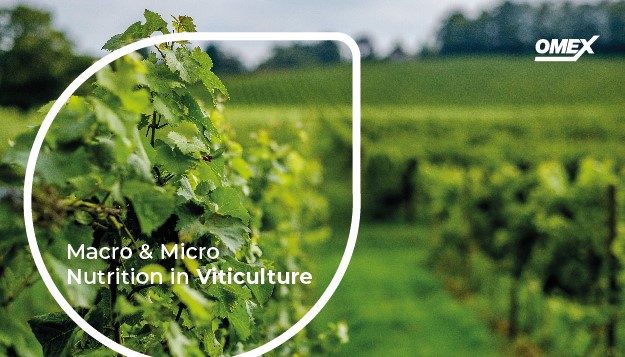Agronomist, Dr Neil Holmes, gives an annual review of macro and micro nutrition in viticulture.
Analysis of SAP samples sent to the OMEX laboratory from the whole of 2022 suggests that nitrogen, phosphorous and potassium uptake could all be increased over the season (see Figure 1 below). During fruit formation, potassium uptake was at sub-optimal levels which could have downstream implications for the sugar or brix measurement of the fruit when it comes to harvest.
 Figure 1 Nitrogen (green), phosphorous (orange) and potassium (blue) SAP Analysis from 2022.
OMEX SAP analysis also showed that the vine’s calcium requirement increases as the season develops (Figure 2). This is of little surprise as the plant architecture develops as the season progresses along with the need to support fruit formation.
Figure 1 Nitrogen (green), phosphorous (orange) and potassium (blue) SAP Analysis from 2022.
OMEX SAP analysis also showed that the vine’s calcium requirement increases as the season develops (Figure 2). This is of little surprise as the plant architecture develops as the season progresses along with the need to support fruit formation.
 Boron and calcium are synergistic nutrients. The uptake of the one benefits the other. Periods of high boron requirement are during pollination, fruit formation and prior to winter to ensure the vine does not succumb to severe frosts.
Therefore, applications of foliar calcium and boron in CalMax Ultra should be consistently applied through the growing season and into fruit formation.
To meet the demands of the developing vine, consider weekly applications of alternating Bio 20 at 3L/ha with CalMax Ultra 1.0L/ha. Both should be applied with NA13 at 0.1% of spray volume.
Boron and calcium are synergistic nutrients. The uptake of the one benefits the other. Periods of high boron requirement are during pollination, fruit formation and prior to winter to ensure the vine does not succumb to severe frosts.
Therefore, applications of foliar calcium and boron in CalMax Ultra should be consistently applied through the growing season and into fruit formation.
To meet the demands of the developing vine, consider weekly applications of alternating Bio 20 at 3L/ha with CalMax Ultra 1.0L/ha. Both should be applied with NA13 at 0.1% of spray volume.
 Figure 2 Calcium (black) and boron (grey) SAP analysis from 2022.
Macro and micro nutrition in viticulture can be discussed with OMEX's team of technical managers who are experienced in vine nutrient management programmes. To speak to your local technical manager, click here
Figure 2 Calcium (black) and boron (grey) SAP analysis from 2022.
Macro and micro nutrition in viticulture can be discussed with OMEX's team of technical managers who are experienced in vine nutrient management programmes. To speak to your local technical manager, click here
 Figure 1 Nitrogen (green), phosphorous (orange) and potassium (blue) SAP Analysis from 2022.
OMEX SAP analysis also showed that the vine’s calcium requirement increases as the season develops (Figure 2). This is of little surprise as the plant architecture develops as the season progresses along with the need to support fruit formation.
Figure 1 Nitrogen (green), phosphorous (orange) and potassium (blue) SAP Analysis from 2022.
OMEX SAP analysis also showed that the vine’s calcium requirement increases as the season develops (Figure 2). This is of little surprise as the plant architecture develops as the season progresses along with the need to support fruit formation.
 Boron and calcium are synergistic nutrients. The uptake of the one benefits the other. Periods of high boron requirement are during pollination, fruit formation and prior to winter to ensure the vine does not succumb to severe frosts.
Therefore, applications of foliar calcium and boron in CalMax Ultra should be consistently applied through the growing season and into fruit formation.
To meet the demands of the developing vine, consider weekly applications of alternating Bio 20 at 3L/ha with CalMax Ultra 1.0L/ha. Both should be applied with NA13 at 0.1% of spray volume.
Boron and calcium are synergistic nutrients. The uptake of the one benefits the other. Periods of high boron requirement are during pollination, fruit formation and prior to winter to ensure the vine does not succumb to severe frosts.
Therefore, applications of foliar calcium and boron in CalMax Ultra should be consistently applied through the growing season and into fruit formation.
To meet the demands of the developing vine, consider weekly applications of alternating Bio 20 at 3L/ha with CalMax Ultra 1.0L/ha. Both should be applied with NA13 at 0.1% of spray volume.
 Figure 2 Calcium (black) and boron (grey) SAP analysis from 2022.
Macro and micro nutrition in viticulture can be discussed with OMEX's team of technical managers who are experienced in vine nutrient management programmes. To speak to your local technical manager, click here
Figure 2 Calcium (black) and boron (grey) SAP analysis from 2022.
Macro and micro nutrition in viticulture can be discussed with OMEX's team of technical managers who are experienced in vine nutrient management programmes. To speak to your local technical manager, click here 